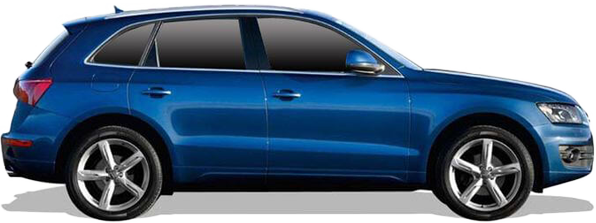The Comparative Analysis :
Audi Q5 2.0 TDI quattro S tronic (14 - 16) vs. Mercedes EQC 400 4MATIC (19 - ..)
€ 42,700

€ 71,300

€ 42,700
Base Price ⓘBase price of a new vehicle with standard equipment in Germany at market launch.
€ 71,300
ⓘBase price of a new vehicle with standard equipment in Germany at market launch. Price Info
Vehicle Dimensions
The dimensions of these vehicles differ slightly. The Audi Q5 2.0 TDI is 5.2 inches shorter, 0.6 inches wider and 1.2 inches taller than the Mercedes EQC 400.
Audi Q5 2.0 TDI
Mercedes EQC 400
65.2
74.7
82.2
63.9
74.2
82.5
74.7 in
Width
74.2 in
82.2 in
Width Incl. Mirrors
82.5 in
65.2 in
Height
63.9 in
110.5
182.2
113.1
187.5
182.2 in
Length
187.5 in
110.5 in
Wheelbase
113.1 in
Vehicle Weight
Audi Q5 2.0 TDI
Mercedes EQC 400
4178 lb
Curb Weight
5501 lb
5357 lb
Gross Vehicle
Weight
Weight
6482 lb

Weight Difference:
1323 lb
24.05 %

General
Audi Q5 2.0 TDI
Mercedes EQC 400
8R
Generation
N293
Sport Utility Vehicle
Car Body Style
Sport Utility Vehicle
Diesel
Fuel Type
Electricity

Permanent all-wheel drive (AWD)
Drivetrain
Permanent all-wheel drive (AWD)

7-speed dual clutch transmission
Transmission
1-speed automatic transmission
Engine
Audi Q5 2.0 TDI
Mercedes EQC 400
Straight-four diesel engine with turbocharger
Engine Type
Asynchronous motor
CAHB, CGLA, CGLD, CNHC
Engine Code
4
Valves
0
4
Cylinders
0
2 L / 98 cu in
Displacement
0 L / 0 cu in
161 hp
at 3000 rpm
Power
402 hp
at 0 rpm
Audi Q5 2.0 TDI
161 hp
402 hp
Mercedes EQC 400
280 lb‑ft
at 1750 rpm
Max. Torque
561 lb‑ft
at 0 rpm
Audi Q5 2.0 TDI
280 lb‑ft
561 lb‑ft
Mercedes EQC 400
Performance
Audi Q5 2.0 TDI
Mercedes EQC 400
122 mph
Maximum Speed
112 mph
9.7 sec
Acceleration 0 to 62 mph
5.1 sec
62 mph
62
mph
mph
443 ft
0.000 sec

Audi Q5 2.0 TDI
62 mph
62
mph
mph
233 ft
0.000 sec

Mercedes EQC 400
▶ REPLAY
25.95 lb/hp
Weight-to-Power Ratio
13.68 lb/hp
Audi Q5 2.0 TDI
25.95 lb/hp
13.68 lb/hp
Mercedes EQC 400
Fuel Economy / Emissions
Audi Q5 2.0 TDI
Mercedes EQC 400
Fuel Economy
41 mpg
( 46 MPGe ⓘ Miles per gallon gasoline equivalent (MPGe) is a measure of the average distance traveled per unit of energy consumed. MPGe, specified in miles per U.S. gallon, is used to compare the energy consumption of vehicles that use different energy sources.)
combined ✽ per 100 miles
32 kWh✽
( 105 MPGe ⓘ Miles per gallon gasoline equivalent (MPGe) is a measure of the average distance traveled per unit of energy consumed. MPGe, specified in miles per U.S. gallon, is used to compare the energy consumption of vehicles that use different energy sources.)
Audi Q5 2.0 TDI
46 MPGe
105 MPGe
Mercedes EQC 400
36 mpg
city
No data
No data
highway
No data
19.8 gal
Fuel Tank Capacity
80 kWh
818 mi
Range
252 mi
Audi Q5 2.0 TDI
818 mi
252 mi
Mercedes EQC 400
Environmental Impact
117.3 kWh
Total Energy Consumption
per 100 miles ⓘThe total energy consumption per 100 miles is the amount of energy consumed by a vehicle when burning fuel or using electricity per 100 miles (final energy), and the energy required to produce the appropriate amount of fuel or electricity (primary energy).
per 100 miles ⓘThe total energy consumption per 100 miles is the amount of energy consumed by a vehicle when burning fuel or using electricity per 100 miles (final energy), and the energy required to produce the appropriate amount of fuel or electricity (primary energy).
64.1 kWh
Audi Q5 2.0 TDI
117.3 kWh
64.1 kWh
Mercedes EQC 400
Euro 6b (NEFZ)
Emission Standard
Elektrofahrzeug
240 g/mi (NEFZ)
CO2 Emissions
0 g/mi (WLTP)
Practical Convenience
Audi Q5 2.0 TDI
Mercedes EQC 400
5
Doors
5
5
No. of Seats
5
1179 lb
Maximum Payload
981 lb
15.3 cu ft
Trunk Volume
14.2 cu ft









44.2 cu ft
Cargo Volume (Seats Down)
41.3 cu ft


















